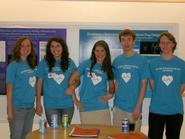
Those in the Science Center last week (July 26-28) will have noticed the elegant tables set out in the atrium and a number of students in dress clothes or the distinctive bright blue "Shieldslab" shirts. Wednesday through Friday, Hamilton played host to the fifth annual MERCURY (Molecular Education and Research Consortium in Undergraduate Computational Chemistry) Computational Chemistry conference.
The MERCURY group is an organization of investigators, faculty and undergraduate students, at eight liberal arts colleges in the United States. Their annual conference is designed to promote undergraduate research in computational chemistry.
Lecturers included Dr. Andras Fiser of the Albert Einstein College of Medicine, Dr. Heather Gordon of the Center for Biotechnology at Brock University, Dr. Yvonne Martin from Abbott Laboratories, Dr. Hugh Nymeyer at Florida State University, Dr. Jeff Saven from the University of Pennsylvania, and Dr. Dagmar Ringe from Brandeis University. The speakers concentrated their discussions on bioinformatics, structural biochemistry, protein folding, and computer-aided drug design.
Thursday afternoon the students gathered in the Science Building's Kennedy Auditorium to give short talks about their research. After an hour and a half of presentations, the students escaped the auditorium and mingled during a more interactive poster session.
The Hamilton students were especially colorful, thanks to whoever had organized the production of a team shirt. Bright, Hamilton blue (though without the buff), the shirts announced "Shieldslab" on the back. The front was embellished with a quotation from Jim Morrison: "love is hidden in molecular structure" and a heart with an organic molecule in the center. Amanda Salisburg '08, a Shieldslab participant, said there was no story behind the shirt, but it looked as though there should be.
Although the MERCURY group is eight U.S. colleges, the attendees were from a much larger area than that. The poster session featured such diverse locations as Brock University, St. Catherine's in southern Ontario; Westminster College, Salt Lake City; Rhode Island College; and even one poster from the Technische Universitat Graz, Austria.
The Hamilton participants admit to some nerves at presenting before such a large group. "I was so nervous," said Amber O'Connor '09, "up there in front of all those people I don't know. I don't mind [small] groups, but…"
"I don't remember [my presentation]" admitted Jim McConnell '07. Greg Hartt '08, who was displaying his poster next to McConnell's, said he too was nervous but that it "got easier." Hartt, attending his third MERCURY conference, ought to know.
Certainly nerves were not completely the order of the day; Russell Holz, one of the three members of the class of 2010 presenting, seemed very calm as he leaned against his poster with a diet coke, and Sharfi Farhana '09 was full of energy. "I am so proud of this thing," she exclaimed, pointing at her pale blue poster.
It is Farhana's comment that seems to be the overall feeling. In Jovan Livada '08 deep in discussion with one of the Brock University students or in the animated clump of blue around the posters for Kristin Alongi '08 and Becky Mackenzie '08, there was a strong sense of pride in work done well. July 28 marked the end of the 10-week science research period and the aura in the Science Center was one of excitement and justified pride.
The MERCURY conference included in total 21 Hamilton students: 17 current students, four recent graduates, and three recipients of the STEP/Dreyfus grant, which allows the students five weeks of summer research before they matriculate.
-- Lisbeth Redfield
